#toshio goto
Text

Masayuki Mori in Love Letter (Kinuyo Tanaka, 1953)
Cast: Masayuki Mori, Juzo Dosan, Yoshiko Kuga, Jukichi Uno, Kyoko Kagawa, Shizue Natsukawa, Kinuyo Tanaka, Chieko Seki, Ranko Hanai, Chieko Nakakita, Keisuke Kinoshita. Screenplay: Keisuke Kinoshita, based on a novel by Fumio Niwa. Cinematography: Hiroshi Suzuki. Art direction: Seigo Shindo. Film editing: Toshio Goto. Music: Ichiro Saito.
3 notes
·
View notes
Photo
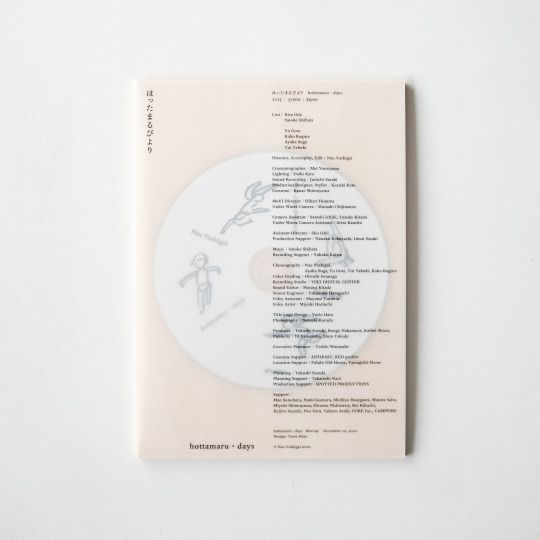
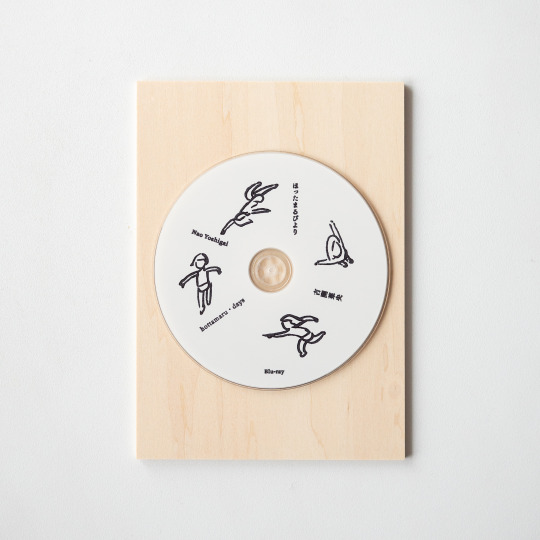
映画「ほったまるびより」Blu-ray
Cast / Risa Oda
Satoko Shibata
Yu Goto
Kaho Kogure
Ayaka Suga
Yui Yabuki
Director, Screenplay, Edit / Nao Yoshigai
Cinematographer / Mai Yoneyama
Lighting / Daiki Kato
Sound Recording / Junichi Sasaki
Production Designer, Stylist / Koyuki Kato
Costume / Kanae Shimoyama
MoVI Director / Hikari Homma
Under Water Camera / Masaaki Chijimatsu
Camera Assistant / Satoshi Ichiki, Yusuke Kitami
Under Water Camera Assistant / Arisa Kaneko
Assistant Director / Sho Ishii
Production Support / Nanako Kobayashi, Omoi Sasaki
Music / Satoko Shibata
Recording Support / Yukako Kaiwa
Choreography / Nao Yoshigai,
Ayaka Suga, Yu Goto, Yui Yabuki, Kaho Kogure
Color Grading / Hiroshi Iwanaga
Recording Studio / TOEI DIGITAL CENTER
Sound Editor / Masaya Kitada
Sound Engineer / Takamasa Haraguchi
Foley Assistant / Mayumi Tsumita
Foley Artist / Miyuki Horiuchi
Title Logo Design / Yurie Hata
Photography / Natsuki Kuroda
Producer / Tokushi Suzuki, Kengo Nakamura, Kaihei Shiota
Publicity / Ui Yamanaka, Shun Takeda
Executive Producer / Toshio Watanabe
Costume Support / ANTIPAST, RED profire
Location Support / Fululu Old-House, Yamagishi-Home
Planning / Tokushi Suzuki
Planning Support / Takatoshi Naoi
Production Support / SPOTTED PRODUCTIONS
Support /
Mao Sonohara, Nami Isomura, Michiyo Hasegawa, Shunta Saito,
Miyuki Shimoyama, Hiromu Nishizawa, Rei Kikuchi, Keijiro Suzuki,
Neo Sora, Takuro Araki, CORE Inc., CAMPFIRE
48 notes
·
View notes
Text
Ch. 7 Associates
AO3: Here
Fanfiction: Here
Summary: Keeping a secret identity secret is normally hard enough but when you’re as beautiful as Minako Aino you’re bound to have all kinds of creeps and weirdo stalking your every move. Now there’s a cop hot on her trail and she’ll have to be quick on her feet if she’s to keep her identity on the DL. Just what is a gorgeous super-heroine to do?
Keisuke arrived in the Azabu-juban district at nine twenty five in the morning with a cramp in his back and an irritable mood weighing him down. He'd only gotten a few hours of sleep the night before after a late night alert went out, calling all hands available to a nearby murder investigation. Luckily Usui had arrived on the scene first, thus making him lead of the investigation and granting Keisuke leeway to return home and try to salvage what sleep he could before his meeting with Ueda later that morning.
He slipped into a nearby cafe to grab a bagel and some coffee and then headed to the nearby bank to withdraw some cash. He was running low on his bribe money and he wanted to restock before seeing Ueda. Not that he thought it would be necessary...it was just better to err on the safe side.
Finishing the last of his bagel, he walked up to a wooden kiosk, grabbed a withdrawal slip and began filling out the form when he noticed a flash of gold in his peripheral. It was Aino entering the establishment, blond hair and sandaled wedges moving confidently across the linoleum floor while carrying a large, navy deposit bag. He dropped his pen in his surprise and cursed when he banged his head on the kiosk when he bent to pick it up.
It seemed today just wouldn't be his day.
"Everybody listen up! This here's a robbery!"
Keisuke—still crouched from his efforts to retrieve the pen— slowly closed his eyes and sighed. Of course the bank was being robbed.
After allowing himself that small display of frustration, he adjusted his crouch to kneel and peeked around the kiosk to better assess the situation. There were five masked men that he could see: two confronting the tellers, two pointing what looked to be AR-15s at roughly a dozen civilians and one blocking the exit. He imagined there was at least one getaway driver nearby but then also figured they could have planned to use the civilians as a bargaining tool. Either way he was outnumbered and outgunned.
He shot off a quick text with these observations, as well as the bank's address, to his superior and moved a few inches back to scrutinize his surroundings and attempt to form a plan.
"Alright, everybody put your hands out in front of ya and drop your valuables and cash in the bag as my friend here passes by and no one will get hurt."
From his position, Keisuke could see the robbers' reflection off the glass office walls and took the moment they were distracted to slip around to the side of the bank's main front counter. His new vantage point allowed him to directly see the thug collecting the civilians valuables with quick efficiency.
Then he stopped in front of Aino.
"Give me the bag blondie. I won't ask twice."
Aino clutched the deposit bag tighter to her chest.
"Did you know that twenty percent of all startups fail within the first year?" she rattled off randomly. Keisuke would have assumed she was nervous if he hadn't seen her take down that rapist the day before.
It seemed to stall the robber however, who stared at her and then looked to his partner who motioned for him to hurry up.
"Alright, er…" The robber frowned and lifted his bag. "That's interesting, miss. Now give me the money!"
Aino appeared not to have heard him though, instead continuing her previous line of conversation with added hand gestures to emphasize her point. "And did you know that that number is tripled when that startup is a new and unknown restaurant? That's a sixty percent failure rate! It's a travesty!" Her hand flew out knocking the bag of stolen goods from the robber's hand to the floor. "Oops! Sorry about that, I'm always knocking over or tripping over something it seems."
The robber hastily snatched up the bag but he'd drawn the attention from his friends, including the ones who'd been harrassing the tellers.
"What are you doing Taka? Take her money already," ordered one of the robbers closest to Keisuke.
Taka reached for the deposit bag but Aino stepped back, managing to avoid him.
"I'm afraid I can't let you do that. You wouldn't want my friend to become just another failed statistic now would you?"
"Lady I don't care what happens to your friend. Just give me the money!"
Aino sidestepped Taka again, earning Taka several jibes from the other robbers. The two crooks harassing the tellers joined the ones harassing the customers and formed a semicircle around Aino. Keisuke used their distraction to slowly rise to a standing position.
"We don't have time for this," the quasi-leader of the group complained. He grabbed Aino's arm and yanked the bag from her fingers before shoving her to the floor and causing her to cry out. Keisuke's hands clenched into fists as he inched closer.
"Hey doesn't she look like that model on all the billboards lately?" asked another.
"She is! We could make a fortune off her!" replied the fourth man, "Imagine what the magazines would pay for her nudes!"
Keisuke tapped the excited robber's shoulder, prompting him to turn around, and then slugged him in the face. The robber's gun flew out of his hands and skidded across the floor while Taka seemingly lost his feet and fell to the ground next to him. Keisuke chalked it up to Aino but didn't waste time to check having already turned to block a bat spiked with nails flying at his head. He managed to catch the bat just beyond the spikes and swung his body towards his assailant's arms before sending an elbow to the other man's face while simultaneously wrenching the weapon free. He then turned to the leader, who was already on the floor with Aino's wedge sandal squishing his face into the linoleum.
Keisuke relaxed his stance, "nice wo—"
"NOBODY MOVE!"
Shit. He had forgotten about the one at the door.
"DROP YOUR WEAPONS! I SAID DROP YOUR WEAPONS!"
Keisuke slowly lowered his weapon to the floor and then stood back up, hands raised high as he turned to face the last robber. Aino likewise had turned around but her hands remained low by her side. The robber guard pointed his weapon at a middle age woman but never took his eyes off them.
"Drop your weapons or this bitch here gets it!"
What on earth was he talking about? Hadn't they done just that? Keisuke frowned and tried to discreetly check Aino's hands in the glass reflections but couldn't see anything past all her blonde hair.
"WHAT ARE YOU DOING? WHAT ARE YOU DOING?"
Keisuke snapped his gaze back to the robber in time to see the gun, surrounded by a golden glow, bend and twist unnaturally until the barrel pointed at its wielder. The robber screamed and hurled the weapon away from him, an action which could be clearly seen beyond the bank's doors because the reinforcements he had called in had finally arrived and wasted no time bursting through the door and tackling the lone robber while the others corralled around the four still unconscious on the floor.
A man—who was clearly in charge given the way the officers responded to him—walked through the doors and Keisuke recognized him as the Commissioner General's second-in-command, a hardworking officer who'd been dedicated to his job for fifteen years named Toshio Wakagi. Wakagi looked around, studying the mess, and then walked up to Keisuke and clapped him on the shoulder.
"Good work, Detective Koizumi correct? I recognize you from the picture you have on file. Your name has been coming up quite a bit back at HQ. You do good work, although..." Wakagi glanced at the men being hauled away. " In this situation, I'd normally write you up for poor judgement. Five against one is too risky but seeing how things worked out I'm going to let it slide."
Keisuke shook his head in denial, "I didn't do it on my own." He pointed towards Aino. "She helped."
Wakagi glanced in Aino's direction and immediately scowled before attempting to regain his composure. However he wasn't quite successful because his face was still twisted in a grimace when he turned back to Keisuke. "Either way Commissioner General Sakurada is going to want to play this up for publicity. Our recruitment numbers have been down and this is just the sort of thing to motivate the faithful citizens of Japan to sign up. Besides, Aino-san's not going to want the attention. Her fans might not like someone capable of violence."
"It was self-defense," Keisuke argued, suspicious of how Wakagi knew Aino but not about to let him besmirch her actions either. A lot of people could have been hurt if not for her. "Besides, even if she agrees, what happens when the press get the video feed? They'll have a field day if they think the police are hiding something."
Wakagi sighed and Keisuke got the impression the other man knew something he didn't.
"I don't think that'll be a problem but just so you're satisfied I didn't tamper with the feed, go ahead and get a copy for yourself first. I'll go and talk to Aino-san." Wakagi gave a short nod goodbye and then walked away to talk with the woman in question while Keisuke was left to wonder exactly how the two knew each other.
He watched Aino light up when she noticed Wakagi and smile a mile wide before elbowing him in the arm and smirking mischievously. The sight left him feeling uneasy and suspicious. If she knew the second-in-command to the Commissioner General, who else was she connected to? Was this why Goto had wanted him to back off? And what had made that weapon twist and glow like that?
Keisuke decided he needed answers, now, more than ever. He pulled out the spare flashdrive he kept in the hidden inner pocket of his leather jacket and headed to the desk where some officers were pulling up security footage. He flashed his badge.
"I'd like to get a copy of that if you don't mind."
oOo
"You know, anyone just arriving on the scene would think you were robbing the bank, carrying a bag of your money around like that," Wakagi told her. Minako recognized the tone. It was the same tone Artemis used when he was preparing for a lecture.
"It's not my money!"
Wakagi looked alarmed and then furious as he demanded she keep her voice down. "What if someone heard you?"
"Relaaaaax," Minako giggled, playfully slapping his arm. "It's my friend's. She's been short staffed all week and didn't have a chance to deposit her earnings last night, so I offered to do so for her this morning."
"Well I'm glad that's easily cleared up but you know it'll be a lot harder for me if the press catches wind of you in the middle of a bank robbery."
"It's not like I planned this!"
"That doesn't make cleaning up your messes any easier," Wakagi shrugged, crossing his arms. "Anyways, I'll do what I can and Sakurada will get in touch if anything comes up."
"Aw, you big softie. What would I do without you?" Minako smiled and then gave him a kiss on the cheek, grinning when he grew flustered and then annoyed in response. She walked away before he could lecture her about "personal space" and "harassment", with Mako's deposit bag securely in hand. It was too bad she hadn't been able to deposit the money but she doubted the tellers would be open for business until at least this evening, if not tomorrow, considering they'd just been held up and nearly robbed.
"And here we thought you needed help," a husky voice chuckled as Minako walked out of the building. She turned and spotted two silhouettes emerging from the shadows.
"Haruka, Michiru," Minako greeted. "I didn't think you'd get here so fast."
"We were in the area," Haruka shrugged.
"Oh?"
"I was hoping to encounter your detective friend," Michiru murmured, stroking her mirror, "I had tried to scry him the day before, to get an idea of who we're dealing with, but I was only able to see a silver mist."
"That's odd." Minako turned back towards the bank and squinted, hoping to catch a glimpse of the detective through the windows. Not that it would help much. She couldn't read auras like Rei or Hotaru, so she wouldn't be able to tell if something was shielding him, and although she was deadly accurate when it came to emotions, Mr. Fox emitted about as many emotions as a rock.
"Wait, he's in there now?" demanded Haruka, clueing in from Minako's actions, and looking ready to have a different sort of encounter with the detective. Mainly one that involved her fist.
Minako sighed, giving up, and turned back around.
"He is. He's the reason you girls came all this way for nothing." She smiled, "Thanks for that by the way."
"No problem. Now if you'll excuse me, I think it's time I have a little chat with your stalker." Haruka grinned, cracking her knuckles as she strode past Minako.
Michiru was quicker, however, and snagged Haruka's arm before she could take more than a single step. "Patience dear. He's currently surrounded by officers."
"What's that matter?" Haruka scowled, settling back down, "Doesn't Minako have the TCPD in her pocket?"
"Just their boss," Minako corrected.
Haruka threw her a disgruntled look that said 'same thing.'
"In either case," Michiru continued, ignoring their interruptions, "I don't think it would be wise. He's merely doing his job. Confronting him would only add you to his list of suspicious suspects and me, as well, by association." She gave Haruka a stern look. "I do not want to become a suspect, Haruka."
"Well then," Minako smiled, bringing the couple's attention back to her, "I suppose that's my cue to leave before he catches me out here talking to you both. You'll tell me if you learn anything further?"
Michiru nodded her acquiesce while Haruka huffed in the background, still itching for a fight.
Minako thanked them again and departed for Mako's cafe. She made it two blocks and around the corner before letting her shoulders drop in fatigue. Using her powers without transforming always left her feeling a little anemic. Good thing Mako-chan had a dark, raspberry mousse hidden in the back fridge with her name on it! She couldn't wait to eat it up.
And then she would call Rei and ask her to "look" deeper into one Detective Koizumi.
We use cookies. By using our services, you acknowledge that you have read and accept our
Cookies
&
Privacy
Policies.Accept
2 notes
·
View notes
Text
INTERVIEW: Naruto Composer Toshio Masuda On Creating Naruto’s Iconic Soundtrack

Whether or not you recognize his name, you’ve certainly heard his music. As a prolific composer for anime over multiple decades, Toshio Masuda’s musical stylings can be heard in series like Excel Saga, MUSHI-SHI, and more, although most people will likely recognize him from his time working on the soundtrack for Naruto. As the person in charge of creating music for the first four seasons of the anime, Masuda assumed responsibility for crafting many of the franchise’s most iconic musical motifs and character themes, as well as defining the series’ unique blend of rock and traditional Japanese instruments that the anime has become known for. On top of creating music for the TV series, Masuda was also responsible for developing the score for the first three Naruto movies: Ninja Clash in the Land of Snow, Legend of the Stone of Gelel, and Guardians of the Crescent Moon Kingdom.
We sat down with Toshio Masuda to talk about the work that went into crafting the Naruto franchise’s iconic sound, what it takes to make music for long-running TV anime, and more!

The soundtrack of Naruto blends modern orchestras with traditional Japanese instruments. What inspired this decision and what considerations were made to balance these two opposing musical styles and instruments together?
Toshio Masuda: My first encounter with rock music that uses a lot of Japanese instruments was 40 years ago ... far before Naruto even existed, in the mid-'80s. At that time, I had just started to become a professional musician, and a friend of mine introduced me to a unique performance group called ISSEIFUBI SEPIA (composed and produced by the genius bassist Tsugutoshi Goto), who were at the peak of their popularity at the time, and I was asked to join their national tour. Their musical style was quite avant-garde at the time, with a mixture of hard rock and traditional Japanese instruments such as taiko, tsuzumi, shinobue, and shamisen. The way they sang and danced fiercely with such music in the background, dressed in bare skin and zoot suits, reminded me of "NIPPONDANJI (Japanese Manhood)". Full of dignity, tension, and Japanese energy. For me, this experience of recreating their music on stage was very useful in creating the music for Naruto decades later.
At the time, useful equipment such as samplers were very expensive, and it was even hard for professional musicians to own one, that it was a hassle to reproduce Japanese instruments. However, it was worth the effort, and by the time the tour started, I had mastered to play shamisen phrases with my right hand while simultaneously playing a Japanese drum pattern with my left hand. In a sense, I learned some acrobatic tricks. Through my involvement with ISSEIFUBI SEPIA, which lasted for nearly a decade, I had the opportunity to fully explore the various possibilities of collaboration between Western tunes and Japanese instruments.
When I was offered the opportunity to work for Naruto, the memories of that time came flooding back to me. The story of Naruto and Japanese rock music were linked in a very natural way in my mind, and the ideas for the soundtrack came relatively easily, without any particular difficulties or worries. So, in other words, the music for Naruto has been in preparation since long before the need for it arose, without me even realizing it, and now it's taking shape at that perfect time. And in conclusion, it was a beginning that came together through many coincidences.

How much insight were you given to future developments in the story that could then be factored into the music you created for the series?
Masuda: I was only involved in the project until Season 4, so it wasn't a very long period of time, and I had been reading Naruto since it was first published in Weekly Shonen Jump, so I had a good grasp of all the stories that were going to be animated. So I don't think there was any particular information that was revealed for the first time at the meeting. However, I don't remember which song it was, but I think I personally took care not to spoil the story when I arranged it. There are fans who only enjoy watching the anime without reading the original, so I tried to arrange the songs as crisply as possible so that they wouldn't be able to predict what would happen later. In other words, fun songs were made really fun and energetic songs were made full of energy. Of course, this was only if there wasn’t a specific request.

What were the challenges you had in producing themes for the TV series versus crafting the soundtracks for the movies?
Masuda: The main difference in music production between the TV series and the movie version is in the way it is created. For the TV series, we made a lot of short songs, but for the movie version, we measured the time for each scene that required a song and made songs for each scene according to the scene’s length.
My first theatrical work was Naruto the Movie: Ninja Clash in the Land of Snow Original Soundtrack. Each section was working on a very tight schedule, so it was difficult to decide on the length of the relevant scene, which made it impossible to start composing. As a result, the production time we had set aside was drastically reduced and I literally had to work frantically with a stopwatch in my hand — it was all-nighter after all-nighter.
It was a bittersweet experience for me, as I managed to finish the project on time after a rush of work that could be described as risking my life. So, if you were to ask me, "What was the most challenging part?” I would have to say, "The battle against time." Most of the time, it's a race against time, and how long you can endure the lack of sleep, so in the end, it's really a trial of strength ... However, this experience has greatly contributed to the improvement of my composition skills, and it goes without saying that my work efficiency has greatly increased since then.
One more difference in composing for movies is the extensive use of live instruments. Naturally, since the theatrical version is projected on a large screen, the background music needs to be on a scale appropriate to the screen. That's why the string section, percussion, rhythm section, etc. were performed live, as much as the budget allowed. Meanwhile, for the TV series, you tend to use a lot of your computer, so you try to make the artificial instruments sound as un-machine-like as possible.
As someone who worked on the music of the franchise from the first Naruto adaptation, how important was it to capture the essence of the characters on the first attempt? How difficult was it to find the right sounds and musical ideas to represent each character?
Masuda: All of the characters in Naruto have very distinct personalities, so I rarely had to worry about them when I was writing the music. However, I had to be careful not to overdo it and made sure not to let the image of the song take precedence. I was a big fan of Naruto myself and I sometimes tended to put too much feeling into it. That's why I tried not to lose my objectivity.
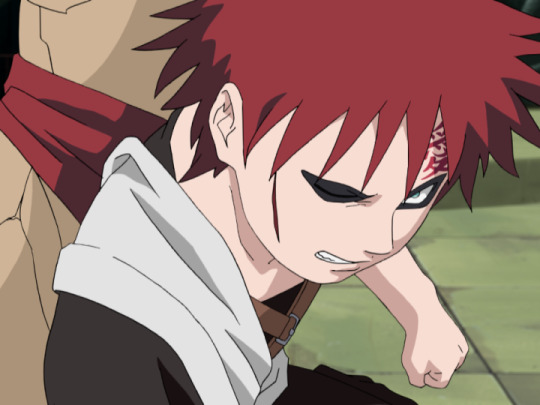
The music of Naruto is pivotal to elevating moments in the original series. While TV anime often involves a lot of creating music that will be reused throughout a series, did you have any conversations with the animation team about crafting major moments and the introduction of new themes, and did this have an impact on your approach to the soundtrack?
Masuda: This is not limited necessarily to the Naruto project, but the direction of the music is rarely determined by the frequency of use. However, if I wanted to create a certain pattern for the production, I would be told about it at a meeting beforehand — for example, if there was a transformational scene or a special move that appears every time. It would be more exciting if there was a memorable music cue for a specific "here and now!" scene throughout the series. For example, "I Said I'm Naruto" and "Go Go Naruto!" from Naruto Original Soundtrack, "Sexiness" for Jiraiya, and "Thunder Break" from Naruto Original Soundtrack 2.
As for the other songs that are played over and over again throughout the series, it just happened that way and not necessarily because I was instructed beforehand.
As for "what music to use and how to use it?” that was decided by the sound director based on the production plan after fully understanding the music we had created in advance. Therefore, there is no need for the composer to think about the frequency of use of the music. In fact, it is better to write music without considering such situations, as it will be easier to get used in various situations. Soundtracks that support an entire series with a limited number of songs are required to have both a clear theme that represents the work and versatility that can withstand a high frequency of use (without becoming boring). When I explain it like this, it may seem like I'm doing something very advanced, but if you compose while looking at the storyboard, picture materials, and listening to the voice actors, strangely it goes well most of the time.
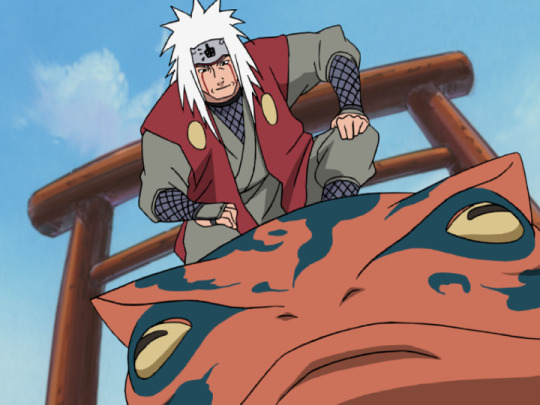
You worked on a number of anime prior to Naruto, but the Naruto franchise was a much larger and long-running project in comparison. Were there any unique challenges that came with composing music for a long-running series like this?
Masuda: This is not limited to Naruto either, but in a long-term series, the number of songs needed naturally increases, and the number of similar developments and situations in the story also increases. It is inevitable that the tunes of the songs will become similar when you make a lot of them, but we always have to keep in mind how to distinguish them from the songs we made in the past. However, since I basically write songs based on the production plan, even if the situation is similar, I have to keep in mind how to handle the scene and the direction of the eyes — "Is it from the protagonist's perspective? Or is it a third person's perspective? Or is it from the viewer's perspective?” etc. — as the tone of the music will naturally change. So, even if you don't change the tune intentionally, it often won't be a problem. Of course, it is a prerequisite that you read and understand the script thoroughly and that you have a lot of "drawers” for ideas ...
And last but not least. To all Naruto fans on the planet, thank you so much for reading this long interview to the very end. It gives me immense pleasure to know that many of the songs I wrote 20 years ago can now be listened to again by fans all over the world, thanks to the immense popularity of Naruto with the support of technology. I would like to express my immense gratitude to Crunchyroll and all the staff involved for giving me such a great opportunity. I will continue to write songs for you to make you guys happy for as long as I am alive.
“Tsukuritsuzukeru Kakugo Dattebayo!!” (“I will keep creating” with Naruto catchphrase — “Believe it!”)
m(_ _)m

Alicia Haddick is a freelance features writer for Crunchyroll. If they aren’t watching anime or way, way too many movies, they’re probably out taking photos on their camera or listening to their favorite idol groups. You can find them sharing their other work on anime, gaming, and film and rambling on just about anything over on their Twitter account @socialanigirl, or on Letterboxd.
Do you love writing? Do you love anime? If you have an idea for a feature, pitch it to Crunchyroll Features!
By: Alicia Haddick
0 notes
Text
Cách một doanh nghiệp Nhật Bản tồn tại hơn 1.000 năm

Ichiwa chỉ bán mochi nướng, đã tồn tại qua nhiều cuộc chiến tranh, thiên tai, thảm họa tự nhiên và sự thăng trầm của các triều đại.
Gia đình bà Naomi Hasegawa (60 tuổi) bán bánh mochi nướng trong một cửa hàng nhỏ bằng gỗ gần một ngôi đền cổ tại Kyoto. Họ mở cửa hàng từ năm 1000, để phục vụ người dân trên khắp Nhật Bản đến đây cầu nguyện đại dịch chóng kết thúc.
Giờ đây, sau hơn 1.000 năm, đại dịch mới lại đang tàn phá kinh tế Kyoto khi nguồn khách du lịch trọng yếu biến mất. Dù vậy, nhà Hasegawa không lo ngại về tài chính của mình.
Cũng như nhiều doanh nghiệp khác tại Nhật Bản, công ty của bà - Ichiwa có tầm nhìn dài hạn. Bằng việc đặt truyền thống và sự ổn định lên trên lợi nhuận và tăng trưởng, Ichiwa đã tồn tại qua nhiều cuộc chiến tranh, thiên tai, thảm họa tự nhiên và sự thăng trầm của các triều đại. Trải qua cả nghìn năm, món bánh mochi nướng của họ vẫn không thay đổi.
Những doanh nghiệp này có thể kém năng động so với doanh nghiệp ở nhiều nước khác. Tuy nhiên, sự tồn tại của họ cũng là bài học với công ty tại các quốc gia như Mỹ - nơi đại dịch đã buộc hàng chục nghìn công ty phá sản.
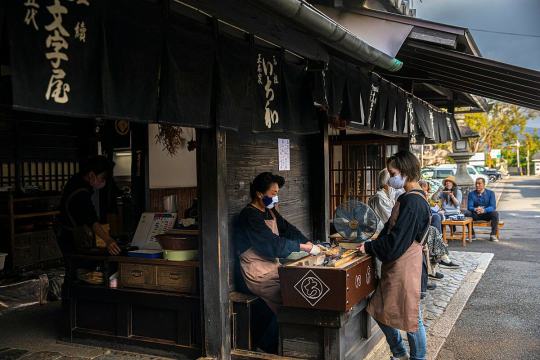
Ichiwa phục vụ người đến cầu nguyện tại một ngôi đền gần đó. Ảnh: NYT
"Trong các cuốn giáo trình kinh tế, các doanh nghiệp được dạy là phải tối đa hóa lợi nhuận, tăng quy mô, thị phần và tốc độ tăng trưởng. Tuy nhiên, nguyên tắc hoạt động của các công ty này hoàn toàn khác", Kenji Matsuoka - Giáo sư tại Đại học Ryukoku tại Kyoto cho biết, "Ưu tiên số một của họ là có thể tiếp tục hoạt động. Mỗi thế hệ giống như một tuyển thủ trong cuộc chạy tiếp sức. Điều quan trọng là phải chuyền được gậy cho người sau".
Nhật Bản nổi tiếng với các doanh nghiệp lâu đời. Quốc gia này hiện là quê hương của hơn 33.000 công ty có tuổi đời từ 100 năm trở lên, chiếm 40% số công ty nhóm này trên thế giới. Hơn 3.100 doanh nghiệp đã tồn tại ít nhất 200 năm. Khoảng 140 đã hoạt động hơn 500 năm và ít nhất 19 khẳng định đã qua 1.000 năm.
Các công ty này được gọi là "shinise" trong tiếng Nhật và là niềm tự hào của quốc gia này. Chính quyền địa phương quảng cáo sản phẩm của họ. Sách quản trị lý giải bí quyết thành công của họ. Hướng dẫn viên du lịch cũng nhiệt tình với các công ty này.
Phần lớn các doanh nghiệp lâu đời như Ichiwa là công ty gia đình nhỏ, cung cấp các sản phẩm và dịch vụ truyền thống. Tuy nhiên, một số lại khá nổi tiếng, như Nintendo - bắt đầu là công ty sản xuất lá bài cách đây 131 năm, hay hãng nước tương Kikkoman đã hoạt động từ năm 1917.
Để tồn tại qua cả thiên niên kỷ, Hasegawa cho biết một doanh nghiệp không thể chỉ theo đuổi lợi nhuận. Họ cần có mục đích cao hơn. Trong trường hợp của Ichiwa là tín ngưỡng. Họ phục vụ những người hành hương đến đến thờ.
Những giá trị cốt lõi này được gọi là "kakun", giúp các công ty ra quyết định kinh doanh suốt nhiều thế hệ. Họ quan tâm đến nhân viên, hỗ trợ cộng đồng và hướng đến sản phẩm khơi lên sự tự hào.
Với Ichiwa, điều này đồng nghĩa chỉ làm một thứ và làm thật tốt. Đây là cách tiếp cận của rất nhiều doanh nghiệp Nhật Bản.
Công ty này đã từ chối rất nhiều cơ hội mở rộng, gần nhất là đề nghị từ Uber Eats để giao hàng online. Mochi đến nay vẫn là sản phẩm duy nhất trong thực đơn của họ. Nếu bạn muốn thêm đồ uống, có thể chọn trà xanh.
Trong phần lớn lịch sử tồn tại của Ichiwa, phụ nữ trong gia đình Hasegawa làm bánh với công thức gần như không đổi. Nhưng dĩ nhiên, họ vẫn hiện đại hóa một số thứ. Ví dụ, giới chức y tế địa phương đã cấm dùng nước giếng. Hay Ichiwa đã mua máy nghiền gạo để tiết kiệm vài giờ lao động mỗi sáng. Bên cạnh đó, sau nhiều thế kỷ để khách tự giác trả tiền, họ đã niêm yết giá cố định cho mỗi đĩa. Việc này thay đổi sau Thế chiến II, khi công ty bắt đầu quan tâm hơn đến tài chính.
Các công ty Nhật tồn tại lâu đời cũng thường có quan điểm phòng trừ rủi ro (vốn được định hình sau các cuộc khủng hoảng trước) và tâm lý tích trữ tiền mặt. Việc này lý giải một phần nguyên nhân Nhật Bản tránh được tỷ lệ phá sản cao như Mỹ trong đại dịch. "Kể cả khi có lợi nhuận, họ cũng không tăng chi tiêu", Tomohiro Ota - nhà phân tích tại Goldman Sachs cho biết.
Các doanh nghiệp lớn thường giữ rất nhiều tiền mặt để đảm bảo họ có thể tiếp tục trả lương và đáp ứng các nghĩa vụ tài chính trong trường hợp kinh tế đi xuống. Tuy nhiên, kể cả các doanh nghiệp nhỏ cũng có mức nợ thấp và dự trữ trung bình 1-2 tháng chi phí hoạt động, Ota nói.
Khi họ cần hỗ trợ, nguồn tài chính lại khá rẻ và sẵn. Lãi suất tại Nhật Bản nhiều thập kỷ nay rất thấp. Các gói hỗ trợ của chính phủ trong đại dịch càng giúp doanh nghiệp nhỏ tiếp cận vốn với lãi suất gần như bằng 0.
Các shinise nhỏ thường có cơ sở riêng và sử dụng thành viên trong gia đình để giảm chi phí lương. Từ đó, họ tiết kiệm được khối tiền mặt lớn. Khi Toshio Goto - Giáo sư tại Đại học Kinh tế Nhật Bản khảo sát để viết sách về các doanh nghiệp có tuổi đời ít nhất 100, hơn một phần tư cho biết họ có đủ quỹ để hoạt động trong 2 năm hoặc hơn.
Tuy nhiên, điều này không có nghĩa họ không vận động. Rất nhiều công ty thành lập vào khoảng thế kỷ 17, khi Nhật Bản vẫn đóng cửa với bên ngoài, tạo ra môi trường kinh doanh ổn định. Tuy nhiên, trong suốt thế kỷ qua, sự tồn tại đồng nghĩa phải cân bằng giữa duy trì truyền thống và thích ứng với môi trường đang thay đổi nhanh.
Với một số công ty, điều này nghĩa là phải cải tiến mảng kinh doanh cốt lõi. NBK - công ty sản xuất ấm sắt từ năm 1560, hiện sản xuất cả các loại linh kiện máy móc công nghệ cao. Hosoo - một hãng kimono 332 năm tuổi ở Kyoto - đã mở rộng sang mảng nội thất và cả điện tử.
Tuy nhiên, với các doanh nghiệp như Tanaka Iga Butsugu, việc này khá khó khăn. Họ sản xuất các sản phẩm phục vụ cho đạo Phật từ năm 885. Giám đốc đời thứ 72 - Masaichi Tanaka cho biết đại dịch khiến họ gặp khó, nhưng thách thức lớn nhất với họ, và nhiều công ty khác, là dân số Nhật Bản đang già đi và thay đổi sở thích.
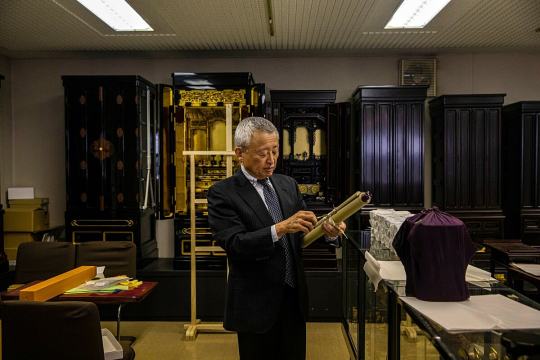
Ông Masaichi Tanaka bên các sản phẩm của công ty. Ảnh: NYT
Một số công ty đã phải đóng cửa vì không tìm được người thừa kế. Với Tanaka, việc tìm thay thế các lao động truyền thống, có tay nghề ngày càng khó. Việc kinh doanh thì bị siết chặt vì giờ ngày càng ít người ghé thăm các đền mà công ty ông cung cấp sản phẩm. Các căn nhà mới xây cũng gần như không làm chỗ cho phòng thờ truyền thống kiểu Nhật Bản nữa.
Bên cạnh đó, với những ngành nghề liên quan đến tín ngưỡng truyền thống, họ gần như không thể hiện đại hóa. Các thiết kế sản phẩm của Tanaka cũng lâu đời như chính công ty vậy. Ông đang cân nhắc đưa máy in 3D vào sản xuất, nhưng lại băn khoăn ai sẽ mua sản phẩm làm ra từ máy này.
Ichiwa thì may mắn không gặp phải những rắc rối này. Gia đình Hasegawa lớn, doanh nghiệp lại nhỏ và kỹ năng đặc biệt duy nhất cần đến khi nướng mochi là chịu nóng.
Dù vậy, bà Hasegawa thi thoảng cũng cảm nhận được sức ép từ lịch sử của cửa hàng. Mọi thành viên trong gia đình đều được dạy từ khi còn nhỏ rằng "Miễn là chúng ta còn sống, cửa hàng phải còn hoạt động".
"Một lý do chúng tôi phải tiếp tục", bà nói, "là chúng tôi ghét trở thành người phải chấm dứt hoạt động của cửa hàng".
Hà Thu (theo NYT)
0 notes
Text
@barks_news
Toshiyuki Goto、TOSHIO MATSUURA、JUZU a.k.a. MOOCHYの三者によるパーティが中目黒solfaにて開催https://t.co/jirBSxvBAU#ToshiyukiGoto #TOSHIOMATSUURA #JUZUakaMOOCHY #solfa
— BARKS編集部 (@barks_news) January 16, 2019
0 notes
Text
Very early response of circulating tumour–derived DNA in plasma predicts efficacy of nivolumab treatment in patients with non–small cell lung cancer
Publication date: November 2017
Source:European Journal of Cancer, Volume 86
Author(s): Yuki Iijima, Yosuke Hirotsu, Kenji Amemiya, Yoshihiko Ooka, Hitoshi Mochizuki, Toshio Oyama, Takahiro Nakagomi, Yoshinori Uchida, Yoichi Kobayashi, Toshiharu Tsutsui, Yumiko Kakizaki, Taichiro Goto, Yoshihiro Miyashita, Masao Omata
IntroductionImmunotherapy has become a treatment option for lung cancer. The utility of nivolumab as second-line treatment for non–small cell lung cancer has been proven, but predictive biomarkers influencing its efficacy remain unknown.MethodsThis study involved 14 patients who were treated with nivolumab from February 1 to September 30, 2016. The early response of the level of circulating tumour DNA (ctDNA) after starting nivolumab was evaluated to ascertain whether it could predict treatment outcome.ResultsOf the 14 patients, six were responders and eight were non-responders. DNA was analysed in both tumour tissue and plasma samples. Only somatic mutations confirmed by analysis of tumour tissue were defined as ctDNA. ctDNA was detected more often in the serial plasma samples of patients with high tumour volume (TV) (p = 0.02). ctDNA was detected in seven cases; basal and serial ctDNA analysis revealed that a decrease in allelic frequency (AF) of ctDNA showed high-level correspondence with a good durable response. When “2 weeks” was set as a clinically significant time point, changes in representative mutations of each case, defined as one of the highest baseline AF, showed 100% concordance with the response.ConclusionsIn patients with high TV, plasma analysis of ctDNA, as validated by tumour tissue, suggested that a durable good response to nivolumab could be predicted within 2 weeks.
http://ift.tt/2hJVWn9
0 notes
Photo
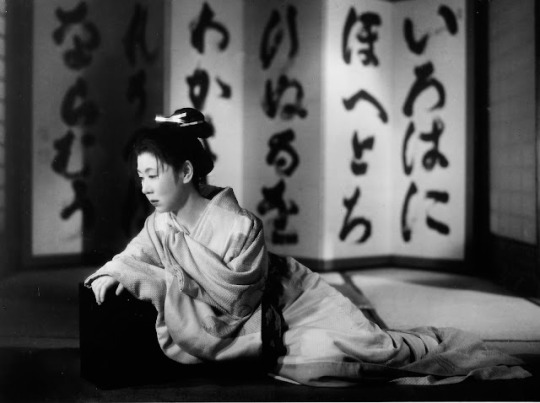
Kinuyo Tanaka in The Life of Oharu (Kenji Mizoguchi, 1952)
Cast: Kinuyo Tanaka, Tsukie Matsuura, Ichiro Sugai, Toshiro Mifune, Toshiaki Konoe, Kiyoko Tsuji, Hisako Yamane, Jukichi Uno, Eitaro Shindo, Akira Oizumi, Kyoko Kusajima, Masao Shimizu, Daisuke Kato. Screenplay: Kenji Mizoguchi, Yoshikata Yoda, based on a novel by Saikaku Ihara. Cinematography: Yoshimi Hirano. Production design: Hiroshi Mizutani. Film editing: Toshio Goto. Music: Ichiro Saito.
Oharu (Kinuyo Tanaka) is by turns a lover, a concubine, a courtesan, a servant, a wife, a prostitute, and a nun, which in the 17th-century Japan of Kenji Mizoguchi's film is almost everything a woman could possibly be. But Tanaka's great performance individualizes Ohara, keeping her from just being a representative figure, a stand-in for Woman. Over the course of the film, Oharu suffers almost every indignity that could be inflicted on her: At the court in Kyoto where she is a lady in waiting, she falls in love with a page, Katsunosuke (Toshiro Mifune), but when their affair is discovered, she and her parents are expelled and he is beheaded. One day a courtier for a powerful feudal lord comes to the village where they are exiled: The lord is in need of an heir, and his wife is barren. Oharu fits his rather exacting specifications to the letter, so she is brought to his palace where she bears him a son, but she's not allowed to nurse the child and is expelled from the household by his jealous wife. She goes to work as a courtesan to pay off the debts incurred by her greedy father (Ichiro Sugai), takes a job as maid to a woman who suspects her of sleeping with her husband, marries a man who is killed by robbers, and becomes a Buddhist nun but is expelled from the temple for supposedly seducing a man who was actually trying to rape her. Years pass and she loses her beauty and now walks the streets to earn money to survive, but she is subjected to scorn and mockery as a "goblin cat" by a man leading a group of young pilgrims. Hope dawns when she is summoned to meet her son, who has succeeded his father as lord, but it turns out that the officials in the court really want to cover up the fact that their lord's mother has been a prostitute, so she runs away after only a brief and distant glimpse of him. At the end she wanders the streets as an itinerant nun receiving alms in exchange for prayers -- her prostitution is now spiritual rather than physical. It's easy to take a synopsis like this and dismiss the story as "lachrymose as a soap opera," and "a reverse Horatio Alger adventure," as a particularly obtuse New York Times review did when The Life of Oharu was first released in the United States in 1964. It is neither of those things, of course. Even the Times reviewer was struck by Tanaka's performance, Mizoguchi's direction, and Yoshimi Hirano's cinematography, without understanding how or why these elevate the story into art. The story comes from a 17th-century novel by Saikaku Ihara, The Life of an Amorous Woman, a work far more erotic and picaresque than the melancholy screenplay Mizoguchi and co-screenwriter Yoshikata Yoda derived from it. The Life of Oharu is unremittingly grim -- it put me in mind of the novels of Thomas Hardy, whose characters suffer more than seems absolutely necessary for the author to make his point about the workings of fate. But the film is not about suffering; it's about strength, and women's strength in particular.
8 notes
·
View notes
Photo
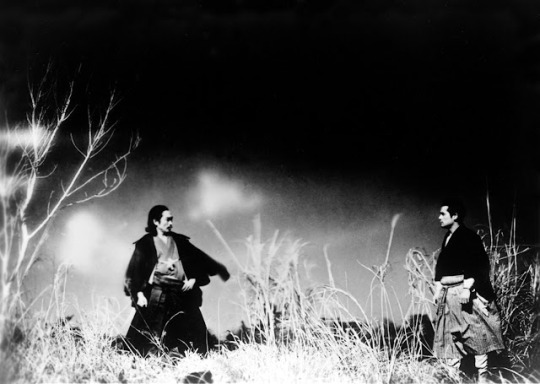
Ryunosuke Tsukigata and Susumu Fujita in Sanshiro Sugata (Akira Kurosawa, 1943)
Cast: Susumu Fujita, Denjiro Okochi, Yukiko Todoroki, Ryunosuke Tsukigata, Takashi Shimura, Ranko Hanai, Sugisaki Aoyama, Ichiro Sugai, Yoshio Kusugi, Kokuten Kodo. Screenplay: Akira Kurosawa, based on a novel by Tsuneo Tomita. Cinematography: Akira Mimura. Art direction: Masao Tozuka. Film editing: Toshio Goto, Akira Kurosawa. Music: Seiichi Suzuki.
You know the plot: A talented, cocky young newcomer takes on the old pros and gets his ass kicked, but he learns self-discipline and becomes a winner. You've seen it played out with young doctors, lawyers, musicians -- it's even the plot of Wagner's Die Meistersinger -- and others challenging the established traditions. But mostly it's the plot for what seems to be about half of the sports movies ever made, including Akira Kurosawa's first feature, Sanshiro Sugata. It's also a film about the conflict between rival martial arts disciplines, jujitsu and judo, but fortunately you don't need to know much about the nature of the conflict to follow the film. From what I gather from reading the Wikipedia entry on judo, the founder of that discipline, Jigoro Kano, wanted to give jujitsu a philosophical underpinning that would put an emphasis on self-improvement for the betterment of society, and he called it judo because "do," like the Chinese "tao," means road or path. Kano's renaming was meant to shift the emphasis from physical skill to spiritual purpose. In Kurosawa's film, young Sanshiro (Susumu Fujita) comes to town wanting to find someone to teach him jujitsu, and signs up with a teacher who accepts a challenge from the judo master Shogoro Yano (Denjiro Okochi) -- the name is an obvious twist on "Jigoro Kano." Sanshiro watches as not only the teacher but all of the other members of his dojo are defeated -- in fact, tossed into the river -- by Yano. Whereupon Sanshiro becomes a follower of Yano's, but has to undergo some defeats and a cold night spent in a muddy pond before he gets the idea of what judo is all about. The film was not a big hit with the wartime Japanese censors, who wanted more aggression and less philosophy in their movies, so 17 minutes were cut from it, never to be seen again. In the currently available print, the missing material is summarized on title cards, but what's left is more than enough to show that Kurosawa arrived on the scene as a full-blown master director. His camera direction is superb, and he knows how to tell a story visually. For example, when Sanshiro joins up with Yano, he kicks off his geta, his wooden clogs, so he can pull Yano's rickshaw more efficiently. Kurosawa cuts to a passage-of-time montage in which we see one of the abandoned geta lying in the road, then in a mud puddle, covered with snow, then tossed aside as spring comes. The film's crucial scene is a showdown between Sanshiro and his jujitsu rival, Higaki (Ryunosuke Tsukigata), in a field of tall grasses, swept by wind with rushing clouds overhead; it's a spectacular effect, even if the battle turns out to be a bit anticlimactic. However much the censors may have disliked it, audiences were enthusiastic enough that Kurosawa was persuaded to make a sequel.
Sanshiro Sugata, Part Two (Akira Kurosawa, 1945)
Cast: Susumu Fujita, Denjiro Okochi, Ryunosuke Tsukigata, Akitake Kono, Yukiko Todoroki, Soji Kiyokawa, Masayuki Mori, Kokuten Kodo, Osman Yusuf, Roy James. Screenplay: Akira Kurosawa, based on a novel by Tsuneo Tomita. Cinematography: Takeo Ito. Production design: Kazuo Kubo. Film editing: Akira Kurosawa. Music: Seiichi Suzuki.
Patched together from what aging film stock could be gathered during the end-of-war shortages in Japan, and interrupted during its filming by bombing raids, Sanshiro Sugata, Part Two was a labor imposed on the writer-director by the studio, Toho, and Kurosawa's lack of enthusiasm for the project shows. The story is routine: Sanshiro has helped judo triumph over jujitsu as the primary Japanese martial art, but he has gone into retreat for several years, honing his spirituality. But one day he comes across an American sailor (Osman Yusuf) beating up a rickshaw driver -- a job he once took on himself -- and thrashes the bully. This brings him to the attention of a promoter who wants to stage a fight between the judo master and an American boxer named William Lister (Roy James). Eventually, after another fighter is beaten to a pulp by Lister, Sanshiro gives in and thrashes Lister, giving the prize money to the fighter who had been beaten. Meanwhile, his old opponent, Gennosuke Higaki (Ryunosuke Tsukigata), whom he defeated at the end of the first film, warns him that his brothers, Tesshin (also Tsukigata) and Genzaburo Higaki (Akitake Kono), are out to revenge themselves for Gennosuke's defeat. They are masters of karate, which originated on Okinawa and was just making its way into mainland Japan at the time when the film is set, the late 19th century. Gennosuke gives Sanshiro a scroll depicting the basics of karate to help him in the eventual fight with the brothers. Naturally, the film concludes with a fight between Sanshiro and Tesshin -- the other brother is recovering from an epileptic seizure -- that takes place in the snow, an echo of the fight in the original film with Gennosuke in a windswept field of tall grasses. This battle is the only part of the film that shows much commitment on the part of Kurosawa, who insisted that the principals fight barefoot in the snow, not without many complaints from the actors. Unfortunately, the poor film stock, unable to provide shades of gray, turns much of this fight into a battle of silhouetted figures. Much has been made of the propaganda in the film, particularly the portrayal of the hapless American sailor and boxer, but Kurosawa, no lover of the imperial regime, manages to shift the film's emphasis to the fearsomely wild Higaki brothers.
3 notes
·
View notes
Text

Shigeru Amachi in Jigoku (Nobuo Nakagawa, 1960)
Cast: Shigeru Amachi, Utako Mitsuya, Yoichi Numata, Hiroshi Hayashi, Jun Otomo, Akiko Yamashita, Kiyoko Tsuji, Fumiko Miyata, Akira Nakamura, Kimie Tokudaiji, Akiko Ono, Hiroshi Izumida. Screenplay: Nobuo Nakagawa, Ichiro Miyagawa. Cinematography: Mamoru Morita. Production design: Shosuke Sasane, Haruyasu Kurosawa. Film editing: Toshio Goto. Music: Michiaki Watanabe.
I know what hell is: listening to elevator music interrupted by assurances that "your call is important to us" while on infinite hold. Which is not the idea that director Nobuo Nakagawa and co-screenwriter Ichiro Miyagawa present. It's pretty much the traditional one of fire and torture. Jigoku is a cult film, as many of the better (or at least more arty) horror films become, and while I'm not a member of the cult I can appreciate the skill with which Nakagawa presents his vision. It's a movie that ranges from deeply somber to extraordinarily lurid. The protagonist, Shiro (Shigeru Amachi), is a student who, after celebrating his engagement to Yukiko (Utako Mitsuya), gets into a car driven by his sardonic friend Tamura (Yoichi Numata). On a dark road, Tamura runs down and kills a gangster, Kyoichi (Hiroshi Izumida), whose mother (Kiyoko Tsuji) witnesses the accident. Shiro wants to stop, but Tamura keeps driving. Since her son was a gangster, she doesn't report the hit-and-run to the police but, along with Kyoichi's girlfriend, Yoko (Akiko Ono), vows to hunt down Tamura and Shiro and kill them. After pleading with Tamura, Shiro decides to go to the police himself, but on the way the taxi driver -- whom Shiro briefly hallucinates as Tamura -- runs into a tree and Yukiko, who has reluctantly accompanied Shiro, is killed. Shiro's road to hell is certainly paved with good intentions, and after his death he winds up there. He has received a telegram that his mother is critically ill, so he goes to see her at the home for the elderly that his father runs in the country. She's not as ill as he feared -- the telegram was actually sent by Kyoichi's mother and girlfriend to lure him into their trap. He discovers that the old folks' home his father owns is actually run on the cheap, with a doctor who skimps on medicine and food. He also encounters Sachiko, a young woman who looks exactly like his fiancée, Yukiko, down to the pink parasol she carries. She turns out to be the sister Shiro didn't know he had, but by this time revelations are coming hard and fast: Tamura -- who appears more and more demonic -- turns up too, as do the potential assassins, and in an elaborate concoction of circumstances, everybody dies, including Shiro. And everybody goes to hell, which is a fantasia crafted out of depictions from old Buddhist paintings and traditional cinematic imaginings of the underworld. Shiro learns there that the taxi accident killed not only Yukiko but also their unborn child, and he spends much of his time trying to rescue the infant from the torments of the afterlife. The film ends, after much exploration of the more gruesome torments of hell, with Shiro's vision of the twinned Yukiko and Sachiko, both with pink parasols, but although it suggests Faust being redeemed by Gretchen, there's nothing to indicate that this is any kind of redemption for Shiro. In short, Jigoku is complicated, contrived, confusing, sometimes a little cheesy and more than a little morally questionable -- does Shiro really deserve to go through all this? -- but also thoroughly fascinating.
0 notes
Photo


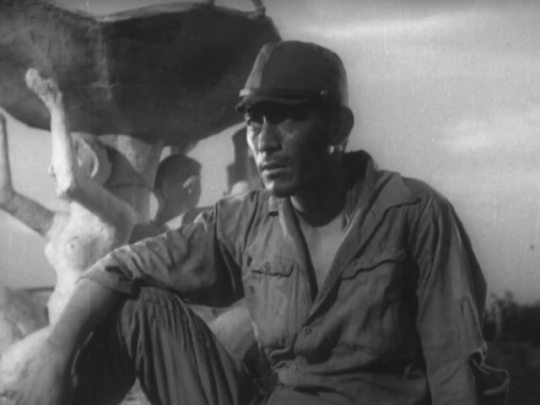
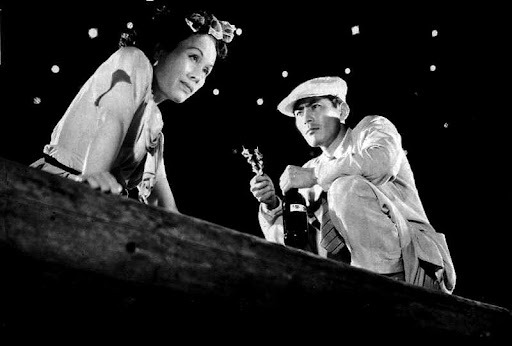

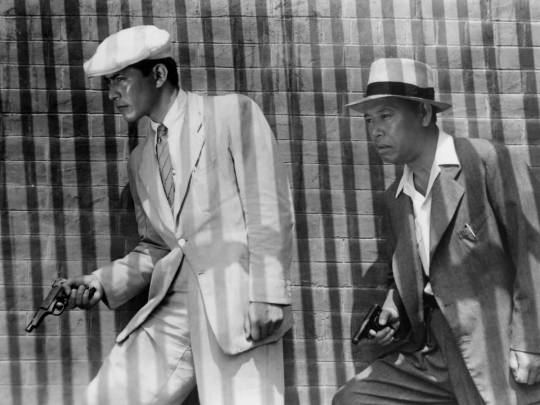
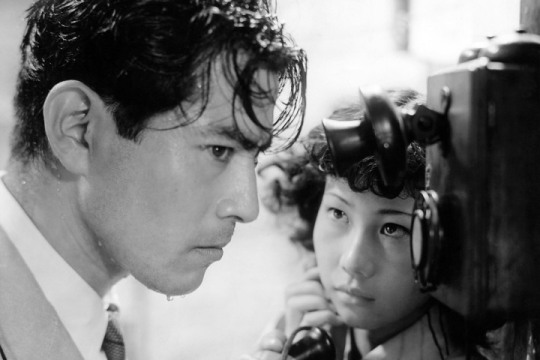



Stray Dog (Akira Kurosawa, 1949)
Cast: Toshiro Mifune, Takashi Shimura, Keiko Awaji, Eiko Miyoshi, Noriko Sengoku, Noriko Homma, Reikichi Kawamura, Eijiro Tono, Yasushi Nagata, Isao Kimura. Screenplay: Ryuzo Kikushima, Akira Kurosawa. Cinematography: Asakazu Nakai. Production design: Takashi Matsuyama. Film editing: Toshio Goto, Yoshi Sugihara. Music: Fumio Hayasaka.
On a sweltering summer day in Tokyo, Murakami (Toshiro Mifune), a police detective new to the job, finds that his gun has been stolen on a crowded streetcar. He goes undercover in search of the weapon in the teeming backstreets of the city, redoubling his efforts when a ballistics report reveals that the gun was used in a robbery. Murakami and an experienced senior officer, Sato (Takashi Shimura), discover that the gun passed through the hands of an illicit dealer to a yakuza named Yusa (Isao Kimura). While they're trying to track down Yusa, the gun is used again, this time in a murder. While Murakami is interviewing Yusa's girlfriend, Harumi (Keiko Awaji), Sato follows a lead to the hotel where Yusa is staying. Tipped off, Yusa shoots Sato, wounding him badly but not killing him. An anguished Murakami, having persuaded Harumi to inform on Yusa, pursues him into a forest, where Murakami is shot but manages to wrestle Yusa to the ground and handcuff and arrest him. Stray Dog is not only an exciting “buddy cop” movie, reflecting Akira Kurosawa's interest in American detective movies -- the director cited in particular Jules Dassin's The Naked City (1948) as an influence -- but it also provides a glimpse of gritty postwar Tokyo from the slums to the ballpark. Kurosawa relied on the teaming of the handsome, volatile Mifune and the homely, steady Shimura in several films, and never more effectively than in this one.
16 notes
·
View notes